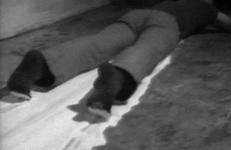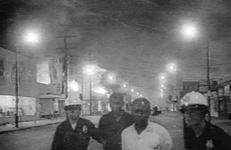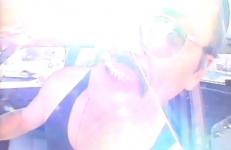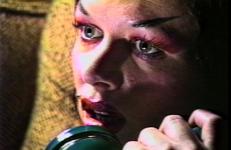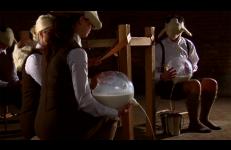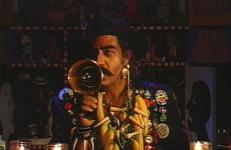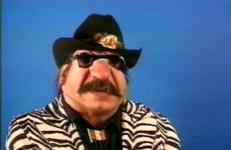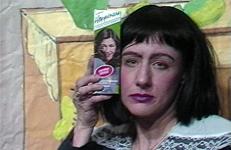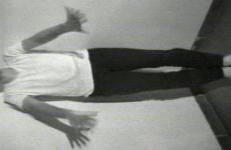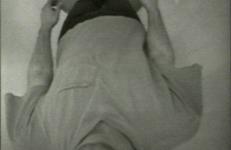Black and White Tapes derive from a series of performances Paul McCarthy undertook in his Los Angeles studio from 1970 to 1975. Conceived for the camera and performed alone or with only a few people present, these short performances use video to articulate both monitor and studio space. In the first excerpt, McCarthy paints a white line on the floor with his face, dragging his body from one end of the studio to the other. In doing so, McCarthy performs a recognizable formal gesture--drawing a white line.
Performance
Subtitled A Rebellion against the Commodity, this engaged reading of the urban black riots of the 1960s references Guy Debord’s Situationist text, “The Decline and Fall of the Spectacle-Commodity Economy,” Internationale Situationniste #10 (March 1966). Along with additional commentary adapted from Barbara Kruger and musicians Morrissey and Skinny Puppy, the text posits rioting as a refusal to participate in the logic of capital and an attempt to de-fetishize the commodity through theft and gift.
A garage in central Portland, Oregon is the setting for this conceptual re-working of James Joyce’s Ulysses. The garage owner Jay, mechanics and neighborhood denizens serve as narrators, reading lines from the novel that focus on death, love, social inequality and the relationship between individuals and the universe.
"An electronic synthetic color video, based on a memory of Larry Gottheim's film Blues. Natural and electronic real time events, new American electronic cinema. B&W video camera, Paik-Abe colorizer, 1/2" vtr, blue berries, bowl and milk. The filmmakers stopped talking to me. Viva Video!"
– Peer Bode
Commissioned to be a "promo" for a loud punk rock band, Mr. Kuchar feared that the noise the band made would spoil the mood of his visuals, so he used the sound of a lush orchestra to score the picture and the antics.
A Body in a Cemetery is a 15-min short film that documents a place-inspired solo performance by dancer/choreographer Eiko Otake in Green-Wood Cemetery, the U.S.’s second oldest cemetery in Brooklyn that holds 570,000 "permanent residents." Presented in September 2020 by Pioneer Works and Green-Wood Cemetery, this event was for many the first time attending a live performance since the pandemic shutdown.
A Body in Fukushima is a film created by dance artist Eiko Otake consisting of still photographs, inter-titles, and an original score. Photographs are selected from tens of thousands taken by historian/photographer William Johnston of Otake alone in the surreal landscapes of post-nuclear meltdown Fukushima, Japan. Otake edited the film and sound, which includes original music by Kronos Quartet’s David Harrington.
M+ Museum presented A Body in Hong Kong in two locations as part of Mobile M+: Live Art, 2015. Tim Mei Avenue, where Eiko chose and performed, was the main site of 2014 Umbrella Revolution. Nearly 100,000 people camped out, and in doing so, stopped traffic on twelve-lane highways and created a politically charged sphere.
M+ Museum presented A Body in Hong Kong in two locations as part of Mobile M+: Live Art, 2015. The second site she chose and performed at on December 11 and 12, 2015 was the West Kowloon Cultural District, the site where the M+ Museum would be built. Eiko perhaps covered a longer distance in this performance than any other in the past. This raw landscape, rather unusual in Hong Kong, and its political tenderness play as a background of her performance. A Body in Hong Kong is part of Otake’s ongoing project, A Body in Places.
During February and March of 2016, Danspace Project presented Platform, a month long curated program for which Eiko's solo project, A Body in Places, was the focus. At the center of the Platform's dense programs were Eiko's daily solos. Eiko presented 21 performances of A Body in Places in different locations at different times of day and night. In A Body in the East Village, both the camera and the gaze of the audience members closely follow three of these intimate and spontaneous performances.
Eiko Otake, based in the United States since 1976, is a highly regarded artist who has performed in many countries as part of the performance duo Eiko & Koma. Her solo project A Body in Places has attracted much attention since it began in 2014, and she performs it for the first time in Japan.
In The Body Parlor, both man and sheep as combined sacrificial bodies become subjects of biological investigation. As symbols of ritual sacrifice, they are bodies that give of themselves. In discovering new forms of health-care (regenerative medicine) and tissue engineering (such as stem cell research), the body becomes sacrificial material for the greater purpose of a social good. The performers employ the material objects, either as products of or as extensions of the body as a way of exploring giving from one's self in sacrifice.
In The Body Parlor, both man and sheep as combined sacrificial bodies become subjects of biological investigation. As symbols of ritual sacrifice, they are bodies that give of themselves. In discovering new forms of health-care (regenerative medicine) and tissue engineering (such as stem cell research), the body becomes sacrificial material for the greater purpose of a social good. The performers employ the material objects, either as products of or as extensions of the body as a way of exploring giving from one's self in sacrifice.
In The Body Parlor, both man and sheep as combined sacrificial bodies become subjects of biological investigation. As symbols of ritual sacrifice, they are bodies that give of themselves. In discovering new forms of health-care (regenerative medicine) and tissue engineering (such as stem cell research), the body becomes sacrificial material for the greater purpose of a social good. The performers employ the material objects, either as products of or as extensions of the body as a way of exploring giving from one's self in sacrifice.
This video shows the design and choreography of Eiko's three-channel installation on one screen. Each video was shot in California by Alexis Moh and Marjorie Hunt during a creative residency at UCLA in April 2019.
In a gallery, three sequences are projected on three different adjacent walls or shown on three monitors separately. Eiko "choreographed" 17-min sequences of three videos, considering the overall dynamic and how they are aligned. This is a shortened version.
Documentation of Eiko performing in the installation space is available by request.
For the November 13, 2015 opening of the Hiroshima Panels by Iri and Toshi Maruki at Pioneer Works, Eiko performed her solo in honor of the Hiroshima Panels and their creators. Japanese-style painter Iri Maruki, born in Hiroshima, and Western-style painter Toshi Maruki, who went into Hiroshima city just three days after the bombing. The artists decided to paint the panels together, which illuminate the human experiences of the Atomic Bomb. They spent 30 years painting the fifteen Hiroshima Panels, six of which were on display at Pioneer Works in Red Hook, Brooklyn.
Sitting at an altar decorated with a kitsch collection of cultural fetish items, and wearing a border patrolman’s jacket decorated with buttons, bananas, beads, and shells, Gómez-Peña delivers a sly and bitter indictment of U.S. colonial attitudes toward Mexican culture and history.
Sitting at an altar decorated with a kitsch collection of cultural fetish items, and wearing a border patrolman’s jacket decorated with buttons, bananas, beads, and shells, Gómez-Peña delivers a sly and bitter indictment of U.S. colonial attitudes toward Mexican culture and history.
This strange, lyrical performance video diary is a millennial reflection on the impossibility to "reveal" one’s self in stormy times such as ours. The piece is also about the intricate connections between performance and everyday life; about language, identity, love, nostalgia and activism amidst the California apocalypse.
Martha Rosler tackles mainstream media's representation of the case of surrogate mother Mary Beth Whitehead.
Nauman is seen standing and leaning back in a corner of his studio. Just as he bounces back to a standing position, his body falls again, momentarily collapsing, only to spring forward once more. This action places his body in an intermittent space, occupying a position halfway between standing and leaning, halfway between the wall and the room.
This title was in the original Castelli-Sonnabend video art collection.
Repeating the same activity as featured in Bouncing in the Corner, No. 1—leaning back and bouncing forward from the corner—this time the camera is positioned just above Nauman’s head. This gives his body the sense of constantly rising and falling, his chin just crossing the bottom edge of the screen before sinking back.
This title was in the original Castelli-Sonnabend video art collection.
Marielle Nitoslawska’s Breaking the Frame is a feature–length profile of the radical New York artist Carolee Schneemann. A pioneer of performance art and avant-garde cinema, Schneemann has been breaking the frames of the art world for five decades by challenging the taboos leveled against the female body. Breaking the Frame is a kinetic, hyper-cinematic intervention, a critical medita-tion on the intimate correlations animating art and life.
Praise for Breaking the Frame:
Filmed in June 1998 at the Whitney Museum of American Art and produced by the New York Public Library for the Performing Arts/Dance Collection. Breath is a creative archive project of Eiko & Koma’s living installation of the same title commissioned by the Whitney Museum. For the living installation Breath, Eiko or Koma was in the installation during all hours that the museum was open.




